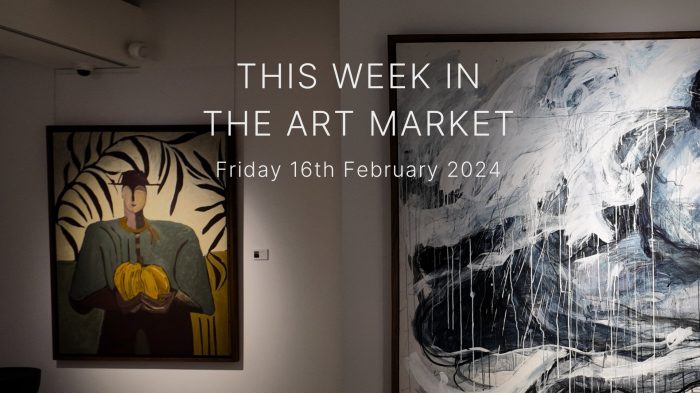China Overtakes the UK as Second Largest Art Market
Overtaking the flagging British art market, China — including Hong Kong — has claimed the title of world’s second largest art market in 2023. This surge in sales is attributed to demand suppressed by strict COVID policies, which has since been lifted. Now, with major fairs and exhibitions returning to full swing, resulting in an increase of 4% in transactions and a increase in value of sales by 70%. Top sales include “Inkstone Washing” from the late Yuan dynasty, which was auctioned off by China Guardian for under $40 million; another, “Rafting in the Wind and Rain” (2019) by eminent contemporary artist Cui Ruzhuo, was sold by Beijing Yongle Auction Company for $33.1 million. However, some commentators have raised concerns over the prevalence of unsettled payments for auctioned art; according to the China Association of Auctioners, only 54% of the value of goods was fully settled in 2023.
See more: https://asia.nikkei.com/Life-Arts/Arts/China-reclaims-No.-2-spot-in-global-art-market-report-says
Art Dubai: The Pinnacle of the Middle Eastern Art Scene
The 17th edition of Art Dubai has proved itself to be indicative of a thriving arts scene in the heart of the United Arab Emirates. This year’s fair sought to re-examine the notion of the ‘Global South’, capitalizing on its cosmopolitan population and access to diverse cultures in the region. To that end, the fair offered a unique selection of Middle Eastern, African and South Asian artists from the Cold War era, as well as works by prominent Iranian, Iraqi, Malaysian, Pakistani, Congolese, and South African artists. The rare curation highlights artists outside of conventional artistic centres (like Paris, New York or Berlin) and celebrates their perspectives and experiences. As gallerist Giula Biafore told Artsy: “Even if [visitors] don’t know the artists, they perceive the quality.” Art Dubai’s success is strong evidence of how traditional poles of the art world are shifting, becoming more inclusive of creative voices from the ‘Global South’. Moreover, gallerists noted an increased presence of buyers from Asia, such as Singapore, Hong Kong, China, India and Pakistan, indicative of the fair’s appeal to diverse patrons outside of Euro-America.
Art Basel Hong Kong Returns to Pre-Pandemic Size
Despite being hit hard by COVID-19, the city of Hong Kong has rebounded in the last year: Hong Kong art exports rose nearly 60% in the first quarter of 2023. Likewise, Art Basel Hong Kong has boasted a 37% increase in exhibitors, with 243 galleries from 40 countries taking part in 2024. This is 1 more than the 242 galleries that participated in 2019, demonstrating that the fair has finally returned to pre-pandemic size. Other than the participation of major international galleries like Spruth Magers and Art & Lisson, 24 first-time galleries have joined the fair, including Japanese gallery √K Contemporary and Taipei-based gallery PTT Space. Hong Kong’s resilience is also proven by the emergence of two new, world-class art museums, M+ for contemporary art and the Palace Museum for antiquities. However, new security laws announced by the Chinese government has sparked concerns among the art industry, though Art Basel Hong Kong director Angelle Siyang-Le has asserted that it seems unlikely for there to be any impact on the local art scene in Hong Kong.
See more: https://www.theartnewspaper.com/2024/03/04/art-basel-hong-kong-finally-back-to-pre-pandemic-size
Changing Tastes at TEFAF 2024
For decades, The European Fine Art Fair (TEFAF) in Maastricht has been the foremost destination for buyers interested in works by Old Masters. However, newer buyers are reportedly less inclined to purchase antiques, favoring instead contemporary works and artists. As a result, the fair has pivoted toward museums and public art institutions which remain invested in expanding their collections with historic works. Out of the event’s 50,000 expected visitors, around 300 would be elite museum directors, constituting a significant presence. TEFAF has also tried to revitalize its selection: in 2024, the number of galleries offering modern and contemporary work exceeded the number of traditional dealers, the former including blue-chip contemporary galleries like White Cube, Galleria Continua, Mennour and Sean Kelly. The mix of contemporary and classic at this year’s TEFAF is highly telling of the market’s shifting tastes, and the burden falls to the fair’s organizers to convince buyers of the lasting value of Old Master works.
See more: https://www.nytimes.com/2024/03/08/arts/design/tefaf-maastricht.html
Insider Perspectives on the Trajectory of the Secondary Market
Speaking to 6 art dealers on the future of the secondary art market, Artsy writer Maxwell Rabb found that despite uncertain outcomes in the 2023 market, insiders generally seem optimistic for 2024 due to falling inflations and widespread predictions of lower interest rates. This sentiment is bolstered by strong outcomes from recent art fairs, with dealers emphasising the market’s ability to recover due to innovation by galleries and gallerists. Across the board, two trends were noted: an obvious gravitation toward high-value works and well-established artists among veteran collectors; and also, the emergence of a younger, digitally-savvy base of collectors seeking to invest in emerging creatives and boosting demand for desirable artists.
See more: https://www.artsy.net/article/artsy-editorial-6-art-dealers-secondary-market-headed-2024








